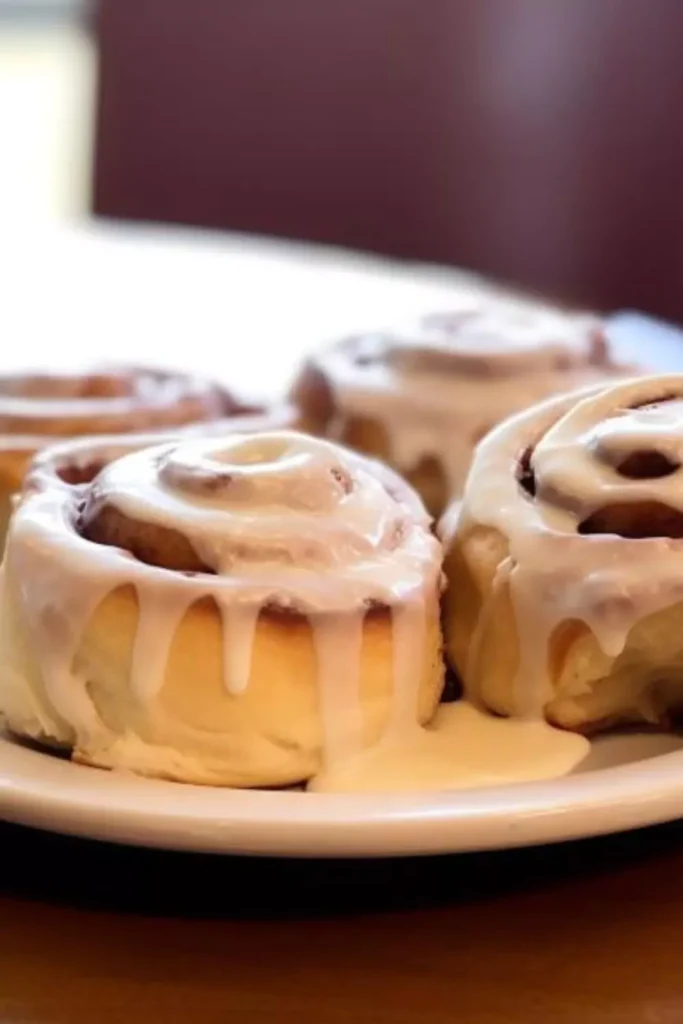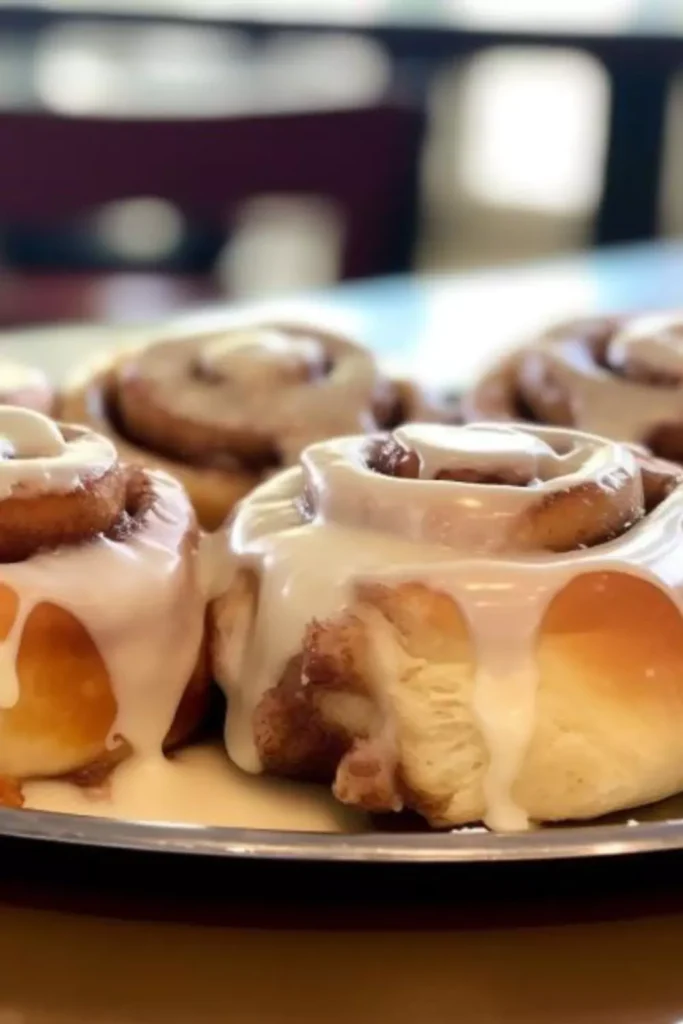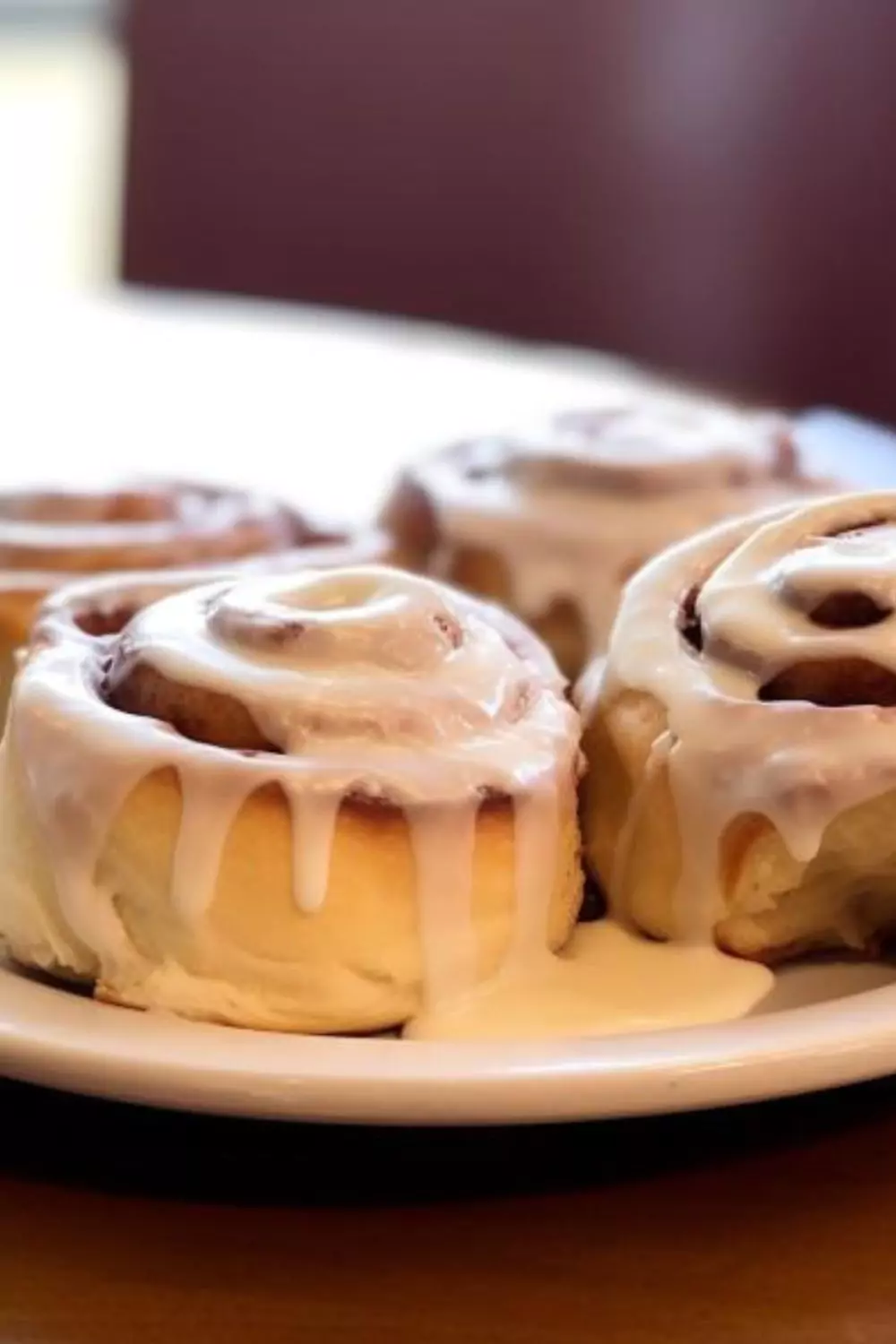Ann Sather’s cinnamon rolls are a beloved classic, celebrated for their sweetness and comforting warmth.
These cinnamon rolls have become synonymous with cozy breakfasts and indulgent treats, earning a special place in the hearts of many. The recipe calls for simple, everyday ingredients like yeast, sugar, butter, and of course, cinnamon, but it’s the way these ingredients come together that makes these rolls truly extraordinary.
Whether you’re attempting to recreate these much-celebrated cinnamon rolls at home or simply learning about them for the first time, Ann Sather’s cinnamon roll recipe is a testament to the timeless appeal of well-made, flavorful baked goods. If you’re ready to embark on a delicious baking adventure, this recipe is a great place to start.

What are Ann Sather cinnamon rolls?
Ann Sather cinnamon rolls are a type of sweet pastry that is made from yeast dough, rolled with cinnamon and sugar, and then baked to golden perfection. They are famous for their rich flavor and tender texture, as well as their mouth-watering aroma that fills the air while they bake.
The story behind Ann Sather’s cinnamon rolls dates back to 1945 when Ann Sather, a Swedish immigrant, opened her first restaurant in Chicago. She quickly gained a reputation for serving delicious and hearty Scandinavian fare, including her famous cinnamon rolls.
Today, the recipe for Ann Sather’s cinnamon rolls has been passed down through generations and is still served at all four of the restaurant’s locations in Chicago. It has also become a staple in many homes, with people all over the country trying to recreate the beloved treat.
Why You’ll Love this Ann Sather cinnamon Rolls?
There are many reasons why you’ll love Ann Sather’s cinnamon rolls. Here are just a few:
- The perfect balance of sweetness and warmth: These cinnamon rolls are not overly sweet, but rave the perfect amount of sweetness to complement the warm and comforting flavors of cinnamon and butter.
- A classic favorite with a twist: While many people have enjoyed cinnamon rolls before, Ann Sather’s version brings a unique twist with its tender dough and rich flavor.
- Easy to make: Despite their seemingly complex appearance, these cinnamon rolls are quite easy to make. With the right ingredients and instructions, anyone can create this delicious treat at home.
You will also like the following dessert recipes!
The Ingredients
- All-purpose Flour: This is the foundation of your cinnamon rolls. It’s what gives the dough its structure and texture. The proteins in the flour interact with the liquid ingredients to form gluten, which gives the dough its elasticity and allows it to rise.
- Active Dry Yeast: Yeast is a key leavening agent. It ferments the sugars in the dough, producing carbon dioxide gas that causes the dough to rise. This results in soft, fluffy cinnamon rolls.
- Sugar: Sugar has multiple roles in this recipe. In the dough, it provides sweetness and helps the yeast to ferment more quickly. In the filling, it combines with the cinnamon to create a characteristic sweet and spicy flavor.
- Warm Water: Warm water is used to activate the yeast. The warmth wakes up the yeast and gets it ready to start fermenting.
- Melted Butter: Butter adds richness and moisture to the dough. It also helps to tenderize the dough by shortening gluten strands. In the filling, it helps the cinnamon-sugar mixture to stick to the dough.
- Milk: Milk contributes to the tenderness and flavor of the dough. The fats in milk enrich the dough, while the sugars in the milk help to brown the crust.
- Salt: Salt enhances the flavor of the other ingredients. It also helps to control the fermentation of the yeast, preventing it from rising too quickly.
- Butter (for filling): The butter in the filling helps to spread the cinnamon and sugar evenly throughout the roll. It also melts during baking to create a gooey, sticky filling.
- Ground Cinnamon: Cinnamon is the defining flavor of cinnamon rolls. It brings a warm, sweet-spicy taste that pairs perfectly with the sweet dough and filling.
- Brown Sugar (for filling): Brown sugar brings a deeper, more caramel-like flavor to the filling than white sugar. It also creates a moist, gooey texture when combined with the butter and cinnamon.
- Melted Margarine (for glaze): Margarine provides a rich, creamy base for the glaze. When melted, it combines smoothly with the powdered sugar and vanilla extract.
- Powdered Sugar (for glaze): Powdered sugar is used for the glaze because of its fine texture. It dissolves easily in the margarine to create a smooth, sweet glaze.
- Vanilla Extract (for glaze): Vanilla extract adds an extra layer of flavor to the glaze. Its sweet, creamy flavor complements the richness of the margarine and the sweetness of the powdered sugar.

Step by Step Instructions
Step 1: Activate the Yeast
- In a large mixing bowl, combine warm water, yeast, and one tablespoon of sugar. Gently stir to dissolve the yeast and allow it to sit for about 5 minutes. This step activates the yeast, a crucial part of the dough’s leavening process.
Step 2: Mix Initial Ingredients
- Add the remaining sugar, melted butter, milk, salt, and half of the flour to the yeast mixture. Mix until well combined. This step creates the initial dough mixture.
Step 3: Gradually Add Flour
- Gradually add in the remaining flour, a little at a time, until the dough becomes firm and slightly sticky. This gradual addition ensures the right consistency of the dough.
Step 4: Knead the Dough
- Turn the dough out onto a floured surface and knead for 5-10 minutes until smooth and elastic. Kneading develops the gluten and creates the dough’s structure.
Step 5: Let the Dough Rise
- Place the dough in a greased bowl, cover it with plastic wrap or a towel, and let it rise for about an hour in a warm place. The dough should double in size during this time, a crucial step for its light and fluffy texture.
Step 6: Roll Out the Dough
- Once the dough has risen, punch it down and roll it out into a large rectangle on a floured surface. This provides the base for the sweet cinnamon rolls.
Step 7: Spread Butter and Add Filling
- Spread melted butter over the entire surface of the dough, leaving about an inch around the edges. This butter layer adds flavor and moisture.
- In a small bowl, mix brown sugar and cinnamon until well combined. Sprinkle this mixture evenly over the melted butter, creating a sweet filling.
Step 8: Roll and Shape
- Roll up the dough tightly, starting from the longer side, and pinch the edges to seal in the filling. This step shapes the cinnamon rolls.
Step 9: Cut and Arrange
- Cut the rolled dough into slices, about 1-2 inches thick, using a sharp knife or a piece of string. This step creates individual rolls.
Step 10: Let the Rolls Rise
- Place the rolls into a greased baking dish and cover with plastic wrap or a towel. Let them rise for about 45 minutes in a warm place, which allows the rolls to expand and become light and fluffy.
Step 11: Preheat the Oven
- Preheat your oven to 350°F (180°C) to prepare for baking.
Step 12: Bake the Rolls
- Once the rolls have risen, bake them in the preheated oven for about 20-25 minutes, or until they are golden brown. This step finalizes the cooking process.
Step 13: Prepare the Glaze
- While the rolls are baking, prepare the glaze by mixing melted margarine, powdered sugar, and vanilla extract in a small bowl. This glaze adds sweetness and a finishing touch to the rolls.
Step 14: Drizzle the Glaze
- Once the rolls are done baking, remove them from the oven and let them cool for a few minutes before drizzling the glaze over the top. This glaze step enhances the flavor and visual appeal of the cinnamon rolls.
Notes
Make sure to use warm, but not hot, water to activate the yeast. If the water is too hot, it can kill the yeast and prevent the dough from rising.
- Don’t over-knead the dough. This can result in tough cinnamon rolls rather than soft and fluffy ones.
- You can adjust the amount of cinnamon and sugar in the filling to suit your taste preferences.
- For an added touch, you can sprinkle chopped pecans or raisins on top of the cinnamon and sugar mixture before rolling up the dough.
- These cinnamon rolls are best enjoyed fresh out of the oven but can also be reheated in the microwave for a quick and delicious breakfast treat. ¼

Nutrition Information
How to store Ann Sather cinnamon rolls?
These cinnamon rolls can be stored in an airtight container at room temperature for up to 2 days. If you want to keep them longer than that, you can freeze them for up to 3 months. To reheat frozen rolls, let them thaw in the refrigerator overnight and then warm them in the microwave or oven before enjoying. You can also store any leftover glaze in the fridge for a few days and reheat it as needed.
Variations
- For a cinnamon roll twist, try adding a layer of chopped apples or peaches before rolling up the dough.
- Swap out the brown sugar and cinnamon filling for a cream cheese and jam filling for a different flavor profile.
- Add in some shredded coconut or chocolate chips to the filling for an extra indulgent treat. ¼

Equipment
- stirrer
- bowl
- Rolling Pin
Ingredients
For the Dough:
- 5 cups all-purpose flour
- 1/2 cup melted butter
- 2 packages of active dry yeast
- 2 cups milk
- 2 teaspoons sugar
- 1/2 cup warm water
- 2/3 cup sugar
- 3 teaspoons salt
For the Filling:
- 1/2 cup butter
- 1 cup brown sugar
- 6 teaspoons ground cinnamon
For the Glaze:
- 1/2 cup melted margarine
- 2 teaspoons vanilla extract
- 1 cup powdered sugar
Instructions
- Step 1:Combine warm water, yeast, and one tablespoon of sugar. Allow the yeast to activate for 5 minutes.
- Step 2: Add the remaining sugar, melted butter, milk, salt, and half of the flour. Mix well.
- Step 3:Gradually incorporate the remaining flour until the dough is firm and slightly sticky.
- Step 4: Knead the dough for 5-10 minutes until it becomes smooth and elastic.
- Step 5: Allow the dough to rise until doubled in size, and covered.
- Step 6: Roll out the dough into a large rectangle.
- Step 7: Spread melted butter over the dough, then sprinkle brown sugar and cinnamon.
- Step 8: Roll up the dough tightly, sealing the edges.
- Step 9: Cut the rolled dough into 1-2 inch slices and arrange them in a greased baking dish. Let them rise, covered, for 45 minutes.
- Step 10: Preheat the oven to 350°F (180°C) in preparation for baking.
- Step 11: Bake the rolls for 20-25 minutes until they turn golden brown.
- Step 12: Mix melted margarine, powdered sugar, and vanilla extract to create the glaze.
- Step 13: After the rolls cool slightly, drizzle the prepared glaze over them.
Notes
- Don’t over-knead the dough. This can result in tough cinnamon rolls rather than soft and fluffy ones.
- You can adjust the amount of cinnamon and sugar in the filling to suit your taste preferences.
- For an added touch, you can sprinkle chopped pecans or raisins on top of the cinnamon and sugar mixture before rolling up the dough.
- These cinnamon rolls are best enjoyed fresh out of the oven but can also be reheated in the microwave for a quick and delicious breakfast treat. ¼
Nutrition
FAQs
- Can I replace the all-purpose flour with whole-wheat or gluten-free flour?
You can, but it will affect the texture of your cinnamon rolls. Whole-wheat flour has more fiber and will make your rolls denser and less fluffy. Gluten-free flour doesn’t contain gluten, the protein that gives dough its elasticity, so the rolls might not rise as much. If you still want to try, consider using a blend of whole-wheat and all-purpose, or a gluten-free blend designed to mimic regular flour. - What’s the role of butter in both the dough and the filling?
In the dough, butter adds richness and moisture, while helping to tenderize the dough by shortening gluten strands. In the filling, melted butter helps the cinnamon-sugar mixture adhere to the dough. As the rolls bake, the butter in the filling melts, creating a gooey, sticky, sweet, and flavorful interior. - How can I ensure that my cinnamon rolls are soft and fluffy, not tough?
The key to soft, fluffy cinnamon rolls lies in the kneading process and proofing time. Over-kneading the dough can result in tough rolls because it develops too much gluten. Also, ensure you give your dough enough time to rise. This rest period allows the yeast to produce gas, causing the dough to puff up and resulting in tender, light rolls after baking. - Why do we use brown sugar in the filling instead of white sugar?
Brown sugar has molasses in it, which gives it a deeper, caramel-like flavor compared to white sugar. When melted with butter and cinnamon, it creates a moist, flavorful filling with a gooey texture, enhancing the overall taste of the cinnamon rolls.
Wrapping Up
In conclusion, Ann Sather’s cinnamon rolls are a classic and beloved treat that has stood the test of time. Whether you’re new to these delicious pastries or a long-time fan, this recipe is sure to bring warmth and happiness to your home. So why not give it a try? You won’t regret it! Happy baking!
Also, remember to share your delicious creations with friends and family. And if you’re lucky enough to live near one of Ann Sather’s locations in Chicago, be sure to stop by and taste the original version for yourself. Enjoy!
